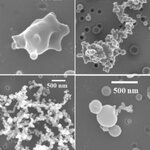Atmospheric

In the zeal to promote carbon dioxide emissions as a magic bullet to stave off climate change, a lot of other factors were minimized. Soot was a big one, but a new study in PNAS suggests that the abrupt retreat of mountain glaciers in the European Alps in the 1860s was due to absorption of sunlight in snow by soot. A rapidly industrializing Europe still gets the blame, but for a different reason.
Their results also show that 'human influence' on glaciers reaches back to well before industrial temperature increases and the work may help to resolve a longstanding scientific debate over when the…

Clouds, which can absorb or reflect incoming radiation and affect the amount of radiation escaping from Earth's atmosphere, remain the greatest source of uncertainty in global climate modeling.
By combining space-based observations with climate models, researchers are able to derive baseline spectral signals, called spectral fingerprints, of how changes in the physical properties of the Earth's atmosphere, such as the concentration of carbon dioxide or the relative humidity, affect the amount of radiation escaping from the top of the atmosphere.
Researchers can then use these spectral…

The radioactive ocean plume from the 2011 Fukushima nuclear incident will reach the shores of the US within three years from the date of the incident - but it will be harmless, according to a new paper.
Atmospheric radiation was detected quickly even in the US but radioactive particles in the ocean plume take considerably longer to travel the same distance so, in the paper, researchers outline a range of ocean simulations they use to track and predict the path of the radiation from the Fukushima incident.
The models identified where it would likely travel through the world's oceans for the…

Satellite pictures of Saharan dust clouds have been in the news all summer - they don't just impact Africa, they even impact air quality in far-away cities like Houston.
Clouds of African dust often migrate across the Atlantic Ocean during summer months, affecting even U.S. air quality from mid-June through mid-September. Chellam said it's especially prevalent in late August and early September.
The dust, whipped up by sandstorms in northwest Africa and carried by trade winds across the Atlantic Ocean, takes about 10 days to two weeks to reach the United States and then even Texas.
Shankar…

It is well known that there are a lot of knobs turning in climate. Current models are assumption-based, with a set of fixed parameters and a solution that involves converging on an answer, and the assumptions impact the value that model accuracy has versus actual accuracy.
To get a good climate model for the future, we first have to have good climate models about the past. Researchers with the GEOMAR Helmholtz Centre for Ocean Research Kiel recently managed to successfully 'hindcast' climate shifts in the Pacific. These shifts also have a profound effect on the average global surface air…

Lots of people who watch the news see when records, some that have stood for a hundred years, are broken in heat waves. But the increase in minimum daily temperatures is telling a more interesting story than maximum ones. Since 1901, nighttime heat waves, when the daily low is in the top 1 percent of the temperatures on record for at least three nights in a row, have quadrupled, according to a new paper.
Researchers found that these nighttime heat waves are becoming more frequent in western Washington and Oregon. It's a good time to stay inside and read this article because, on average, heat…

New evidence is helping to solve the mystery surrounding a collapse of the Antarctic ice sheet 23 million years ago.
The surface of the East Antarctic ice sheet is so cold that models can only simulate its collapse by applying a significant climatic warming. Yet numerous lines of evidence suggest that 23 million years ago the Antarctic ice sheet decayed in size as changes in Earth's orbit around the Sun drove more subtle changes in Earth's seasons.
Scientists from Cardiff University's School of Earth and Ocean Sciences analyzed fossil "foraminifera". These microscopic animals live in the…

The end-Permian mass extinction is the most severe biodiversity crisis in the history of life.
Immediately after the extinction, many marine taxa suffered a dramatic size reduction (i.e., the 'Lilliput Effect') and compiled data show that recovery from the end-Permian mass extinction was not a smooth process but included several episodes of environmental disturbance and three further episodes of extinction.
The third episode of extinction occurs near the Smithian/Spathian boundary (SSB), around 1.8 million years after the end-Permian extinction and was recently associated to an episode…

Wildfires and their witch's brew of carbon-containing particles significantly degrade air quality, damage human and wildlife health, and interact with sunlight to affect climate.
Measurements taken during the 2011 Las Conchas fire near Los Alamos National Laboratory show that the actual carbon-containing particles emitted by fires are very different than those used in numerical models, providing the potential for inaccuracy in current climate-modeling results.
The Las Conchas fire emissions findings underscore the need to provide a framework to include realistic representation of…

A recent increase in polar mesospheric clouds - diffuse collections of water ice crystals in the mesosphere near the poles at altitudes of about 50 miles - could be due to a recent increase in space traffic, a new paper in Geophysical Research Letterssuggests.
The number and brightness of polar mesospheric ice clouds is expected to decrease when the incoming flux of solar ultraviolet radiation increases. Increases in solar radiation both heat and dry out the atmosphere slightly, leading to a decrease in ice cloud formation.
In the past 2 years, the solar ultraviolet flux…